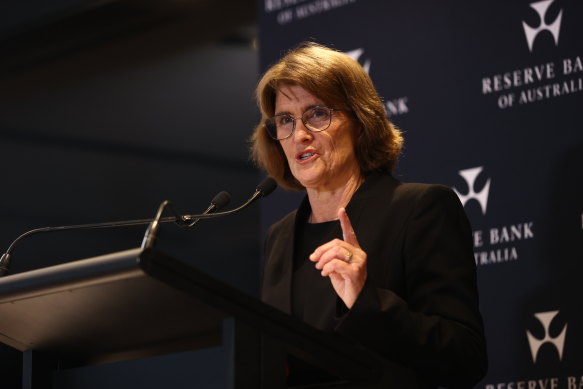RBA ‘will not hesitate to raise rates’ if needed, Bullock says
By Millie Muroi
Reserve Bank governor Michele Bullock says the bank will not hesitate to raise interest rates if it needs to, even as it walks a knife’s edge between taming inflation and preserving jobs, noting regional labour markets have been tighter than those in capital cities.
Speaking on Thursday in the NSW northern tablelands city of Armidale, where she grew up, Bullock reiterated the RBA’s laser focus on inflation when it decided to keep rates on hold at its meeting this week.

RBA governor Michele Bullock said regional labour markets had been tighter than those in capital cities recently.Credit: Dominic Lorrimer
“The board explicitly considered whether another interest rate rise was required to ensure inflation continues to decline in a reasonable timeframe,” she said. “But the board remains vigilant with respect to upside risks on inflation and will not hesitate to raise rates if it needs to. I know this is not what people want to hear.”
On Tuesday, the RBA kept rates at 4.35 per cent, with Bullock noting the economy was still running hot as demand, particularly for services, continued to outpace supply and by a bigger magnitude than previously thought. The Reserve Bank does not expect inflation to return to its target range of 2 to 3 per cent until the end of 2025.
In her speech on Thursday, Bullock flagged the role and consideration of the country’s regions when it came to the RBA’s decisions, saying regional Australia accounted for about one-third of the population and one-third of economic output.
“The [RBA] team regularly speaks with contacts in regional areas and travels to different parts of the country to do this in person,” she said. “We do this because we understand the important role of regional areas in the Australian economy. We systematically factor this information into our forecasts, and it feeds into the board’s decisions on monetary policy.”
The RBA has sought to balance its mandate to get inflation back within the target range against keeping the unemployment rate as low as possible and consistent with maintaining low and stable inflation.
Bullock said while innovation in agriculture had boosted productivity in the regions significantly, it had led to a decline in jobs in that sector. However, she said regional labour markets had been tighter than those in capital cities recently.
“After the pandemic, unemployment rates dropped significantly to very low levels across the country,” she said. “While still at low levels, there has been a more noticeable increase in the average capital city unemployment rate compared with average regional unemployment rates to date.”
Bullock also said housing prices on average had climbed faster in the regions than in metropolitan Australia, partly as a result of population growth in the regions, and that housing supply had not yet responded.
“We know that the strain on household finances from high housing costs is being felt acutely in our regional areas as well as our cities and could continue for some time if construction activity remains low,” she said.
Cut through the noise of federal politics with news, views and expert analysis. Subscribers can sign up to our weekly Inside Politics newsletter.